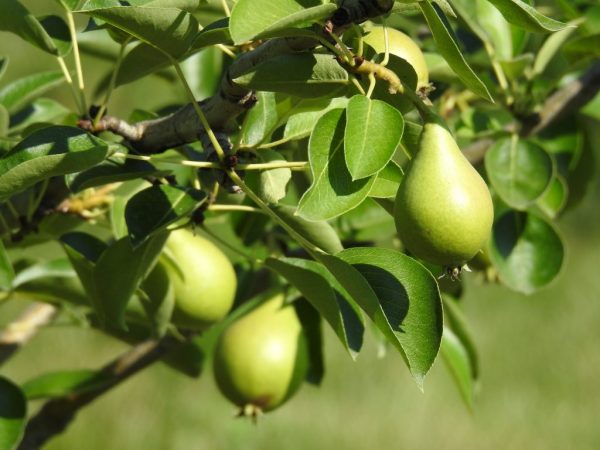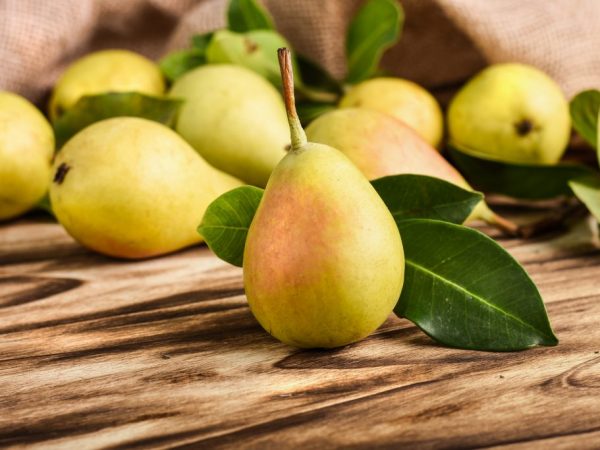Pear varieties for cultivation in central Russia
Pear is a thermophilic culture. She prefers open areas, easily tolerates prolonged drought, is unpretentious to soils, but is afraid of severe frosts. Until recently, only a few managed to grow a fruit beauty on a personal plot. Today, thanks to breeders and agronomists, pear varieties for central Russia have appeared at the disposal of gardeners.

Pear varieties for cultivation in central Russia
Middle lane pears
The middle zone of Russia is distinguished by snowy, moderately frosty winters and rather humid and warm summers. Pears capable of growing under these conditions have the following characteristics:
- the fruiting period begins in the fourth year;
- bountiful harvest every year;
- short or medium height;
- high degree of disease resistance;
- frost resistance.
Gardeners also pay attention to the attractiveness of the fruit. The disadvantage of large, aromatic and bright fruits is their short shelf life. Most of them are practically not transportable.
Gardeners' recommendations
On a personal plot, it is recommended to grow at least 3 types of pears:
- autumn;
- winter;
- summer.
These plants have different periods of fruit ripening.
If the personal plot does not allow planting several full-fledged seedlings, several inoculations are made on one trunk. As a skeleton tree, the Theme variety is suitable.
Growing fruit crops starts with seedlings. The best time for planting is autumn. Seedlings are recommended to be taken at the age of 2 years.
Summer varieties
New summer types of pears ripen in July. The fruits of such trees are consumed fresh, rarely processed into jams, preserves and compotes.
Among the many summer horticultural crops, the following are the best:
- Bashkir summer;
- Messenger;
- Dessert Rossoshanskaya;
- Children's;
- Thumbelina.
Bashkir summer
This culture is distinguished by its versatility, annual fruiting and winter hardiness. The Bashkir summer tree belongs to medium-sized trees. The neat, non-thickened foliage forms a rounded pyramidal shape and exhibits high levels of scab resistance.

The fruits taste good.
The fruits of this beauty reach a weight of 100 g. Fully ripe fruits acquire a yellowish-green color with a weak blush, are characterized by excellent taste, snow-white juicy pulp and a pleasant aroma.
The messenger
By its description, the Messenger is similar to the Bashkir summer one, with the exception of the appearance of the fruits. The harvest of this culture consists of small pears, each weighing 50-60 grams. They hang on elongated stalks. The fruits of the Messenger are sweet, with light coffee pulp, pleasant smell, but not juicy.
Dessert Rossoshanskaya
Dessertnaya Rossoshanskaya belongs to the winter-hardy varieties.Gardeners note its versatility, early maturity and annual abundant fruiting. The crown of the plant forms a pyramid.
Fully ripe fruits weigh 200 g. Light blush on the yellow with green shades of the peel gives pears sophistication. Consumers note good taste, pleasant smell, snow-white compacted juicy pulp.
Children
The baby pear is the earliest variety. Its peculiarity is the different ripening times of fruits on the same tree. The culture is classified as vigorous. The crown of the plant is compact. The variety demonstrates resistance to diseases, pests, easily tolerates midwinter winters.
The bright yellow fruits weigh almost 80 g. The pulp of ripe fruits is creamy, tender and juicy.
Thumbelina
Pear Thumbelina got its name for the size of the fruit. Their weight is no more than 70 g. The brownish-yellow fruits are distinguished by their tender and juicy pulp. The culture is classified as medium-sized. Its highly thickened crown has a rounded dense crown. Thumbelina has good winter hardiness.
Autumn varieties of pears
In the second half of September, autumn varieties of crops begin to ripen. Harvesting from such trees is carried out as the fruits ripen, they are removed slightly unripe: this way you can take care that the fruits do not fall to the ground.
The variety of autumn types of fruit pears allows you to choose seedlings to your taste.
The following pears are popular among gardeners:
- Academic 4-112;
- Bergamot Moscow
- Veles;
- Faithful.
Academic 4-112

This variety pleases with its yield.
The wide-pyramidal dense and compact crown distinguishes Akademicheskaya 4-112 from the description of other pear trees for central Russia. Maroon fruits weigh 150 g each. The snow-white, rich, firm pulp has a sweet taste with a refreshing acidity and a subtle aroma.
The culture of the Akademicheskaya 4-112 variety is characterized as fruitful, scab resistant. The plant requires additional shelter from frost.
Bergamot Moscow
Bergamot Moskovsky belongs to the universal crops. Indicators of winter hardiness and productivity are above average. The plant is scab resistant. Its sparse crown forms a wide oval.
A distinctive feature of Bergamot Moskovsky fruit are large, clearly visible subcutaneous dots on a yellowish-green peel. Gardeners note the good taste of ripe fruits. The pulp of the fruit is characterized by a pleasant aroma, juiciness and pleasant sourness.
Veles
The list of winter-hardy fruit crops includes the Veles pear. The plant is classified as medium-sized with a drooping pyramidal crown. It demonstrates good disease and pest resistance.
The yellowish green fruit weighs 150 g. Delicious, sweet fruit has a juicy creamy flesh.
Faithful
Late varieties of the crop are distinguished by a high degree of winter hardiness. The faithful pear is a typical representative of this group of fruit trees. This is a medium-sized plant with a drooping crown.
Fruits weigh from 90 to 130 g. Juicy cream-colored pulp has excellent taste.
Winter varieties of pears
Winter varieties of pear crops are characterized by a relatively high degree of keeping quality.
Fruits from such trees are plucked unripe, covered with paper or straw and left in a dark, cool place.
Winter pears are characterized by increased frost resistance. Almost all varieties are winter hardy. The latest crop varieties:
- Belarusian late;
- January.
Belarusian late
This culture has a dense crown. The plant is prone to scab, but resists pathogenic bacteria.
Yellowish fruits with a slight blush weigh 100-120 g. The yellowish pulp is distinguished by its juiciness, good taste and subtle aroma.
Belarusian late - the best pear for storage. Its fruits do well at temperatures from -10 ° C to 30 ° C.With a comfortable air humidity for fruits (no more than 80%), fruits are stored until spring.
January
The January pear is distinguished by the sweetest fruits. They should not be left in a warm place: fruits instantly become hard or spoil.
The variety has large fruits weighing up to 200 g with snow-white juicy pulp with a weak aroma.
The winter-hardy and drought-resistant crop demonstrates high scab resistance. It belongs to medium-sized fruit crops with a rounded crown.
Growing pear orchards in central Russia does not present any difficulties. The variety of types of fruit trees allows you to choose the most suitable seedlings for the site.

